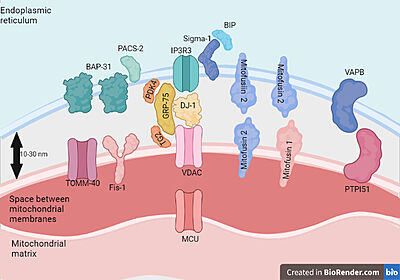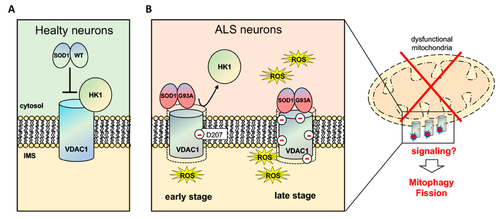User:Maria Carolina Boer Copstein/Sandbox 1
From Proteopedia
(Difference between revisions)
| Line 3: | Line 3: | ||
==Introduction == | ==Introduction == | ||
| - | Three different isoforms of VDAC have been identified, VDAC1, VDAC2, and VDAC3. VDAC1 has been best studied, whereas only limited information regarding the cellular functions of VDAC2 and VDAC3 is available .VDAC1 is a protein present in the outer mitochondrial membrane(OMM) e em outros compartimentos celulares como a membrana plásmatica.VDAC1 controls the metabolic and energy cross-talk between mitochondria and the rest of the cell, mediating the fluxes of ions, nucleotides, and other metabolites across the OMM . This protein is involved in several cellular processes.[[Image:MAM.jpg|400px|left|thumb| Your Caption Text]]VDAC1 has been shown to be a regulator of OMM permeability to Ca2+ | + | Three different isoforms of VDAC have been identified, VDAC1, VDAC2, and VDAC3. VDAC1 has been best studied, whereas only limited information regarding the cellular functions of VDAC2 and VDAC3 is available .VDAC1 is a protein present in the outer mitochondrial membrane(OMM) e em outros compartimentos celulares como a membrana plásmatica.VDAC1 controls the metabolic and energy cross-talk between mitochondria and the rest of the cell, mediating the fluxes of ions, nucleotides, and other metabolites across the OMM . This protein is involved in several cellular processes.[[Image:MAM.jpg|400px|left|thumb| Your Caption Text]]VDAC1 has been shown to be a regulator of OMM permeability to Ca2+.Mitochondria play a major role in different events beyond theircritical bioenergetics function of supplying ATP, such as in cellsignaling events, inter-organellar communication, aging, cell pro-liferation, disease, and apoptosis. Apart from their metabolic role,mitochondria are also a major hub of cellular Ca2+homeostasis thatis fundamental for a wide range of cellular activities, such as controlof oxidative phosphorylation, modulation of cytosolic Ca2+signals,cell death, secretion, and the production of reactive oxygen species(ROS) |
| Line 13: | Line 13: | ||
== Relevance == | == Relevance == | ||
| - | A VDAC1 por ser uma proteína da membrana mitocondrial está envolvida no metabolismo celular além de processos de apoptose dependentes da mitocôndria e regular a homeostase de cálcio e o estresse oxidativo.DAC1 is highly Ca2+-permeable and modulates Ca2+ access to the mitochondrial intermembrane space. Intramitochondrial Ca2+ controls energy metabolism by enhancing the rate of NADH production via modulating critical enzymes in the tricarboxylic acid cycle and fatty acid oxidation. Mitochondrial [Ca2+] is regarded as an important determinant of cell sensitivity to apoptotic stimuli and was proposed to act as a “priming signal,” sensitizing the organelle and promoting the release of pro-apoptotic proteins.Intracellular Ca2+concentration ([Ca2+]i) regulates a number of cellular and intercellular events, such as the cell cycle, proliferation, gene transcription, and cell death pathways, as well as processes like muscle contractility and neuronal processing and transmission (1). The alteration of Ca2+ homeostasis is closely related with various cancer hallmarks, including proliferation, migration, angiogenesis, invasion abilities, and resistance to cell death | + | A VDAC1 por ser uma proteína da membrana mitocondrial está envolvida no metabolismo celular além de processos de apoptose dependentes da mitocôndria e regular a homeostase de cálcio e o estresse oxidativo.DAC1 is highly Ca2+-permeable and modulates Ca2+ access to the mitochondrial intermembrane space. Intramitochondrial Ca2+ controls energy metabolism by enhancing the rate of NADH production via modulating critical enzymes in the tricarboxylic acid cycle and fatty acid oxidation. Mitochondrial [Ca2+] is regarded as an important determinant of cell sensitivity to apoptotic stimuli and was proposed to act as a “priming signal,” sensitizing the organelle and promoting the release of pro-apoptotic proteins.Intracellular Ca2+concentration ([Ca2+]i) regulates a number of cellular and intercellular events, such as the cell cycle, proliferation, gene transcription, and cell death pathways, as well as processes like muscle contractility and neuronal processing and transmission (1). The alteration of Ca2+ homeostasis is closely related with various cancer hallmarks, including proliferation, migration, angiogenesis, invasion abilities, and resistance to cell death.VDAC1 has also been recognized as a key protein in mitochondria-mediated apo-ptosis, contributing to the release of apoptotic proteins located in the inter-membranal space (IMS) andregulating apoptosis via association with pro- and anti-apoptotic members of the Bcl-2 family of pro-teins and hexokinase. |
== Structural highlights == | == Structural highlights == | ||
| - | Human VDAC1 (hVDAC1) adopts a β-barrel architecture composed of 19 <scene name='89/896608/Vdac1_helix/3'>β-strands</scene> with an <scene name='89/896608/Vdac1_helix/2'>α-helix</scene> located horizontally midway within the pore.<scene name='89/896608/Vdac1/3'>Ball and sticks structure</scene> | + | Human VDAC1 (hVDAC1) adopts a β-barrel architecture composed of 19 <scene name='89/896608/Vdac1_helix/3'>β-strands</scene>with strands β1 and β19 being in parallel connformation with an <scene name='89/896608/Vdac1_helix/2'>α-helix</scene> located horizontally midway within the pore.<scene name='89/896608/Vdac1/3'>Ball and sticks structure</scene>N-terminal region of VDAC1, consisting of 25 amino acids,lies inside the channel pore and possesses different degrees of �-helical content in each of the three proposed structures.Various studies using purified rat liver , brain mitochondria or recombinant human VDAC1 have reported that both soluble purified and membrane-embedded VDAC1 can assemble into dimers, trimers, tetramers and higher oligomeric states. VDAC1 oligomerization was also demonstrated in VDAC1-reconstituted liposomes. |
Revision as of 01:48, 13 December 2021
| |||||||||||
References
Magri Andrea ,Messina Angela, “Interactions of VDAC with Proteins Involved in Neurodegenerative Aggregation: An Opportunity for Advancement on Therapeutic Molecules”, Current Medicinal Chemistry 2017; 24(40) . https://doi.org/10.2174/0929867324666170601073920


